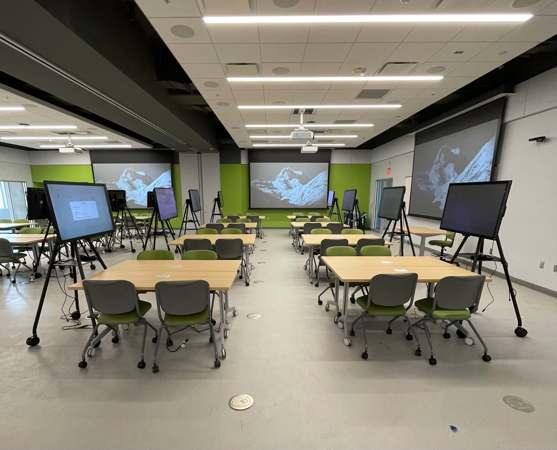Interactive Learning with Technology: Advantages and Real-Life Applications
What is interactive learning?
Interactive learning is a pedagogical approach that helps students acquire knowledge and practical skills by focusing on the interaction between peers and teachers. While traditional teaching strategies rely on the teacher to provide knowledge, with interactive learning, teachers and students contribute to the learning process. Interactive learning as a modern pedagogical approach promotes diverse and engaging learning experiences that are not limited to theoretical concepts but emphasize real-life applications more.
Interactive learning can take place in many ways and through various tools, including but not limited to interactive displays, online platforms, interactive games, or group activities. These forms of learning are particularly effective at fostering the five critical skills for the digital classroom. In the past, learning intensely focused on memorizing facts and figures. Conversely, modern pedagogical strategies, recognizing the importance of these necessary skills in the digital classroom, have shifted towards more meaningful learning experiences.
This way, students can focus on the lesson's content using modern interactive technology, for example completing a microlearning lesson on an interactive display, supporting and engaging students without getting in the way. In addition, one must also remember that interactive learning, when designed and implemented correctly, can cater to various learning styles and makes it easier for all students to feel comfortable in the classroom.
Why interaction is a key aspect of learning

The science of learning continues to point towards effective learning pedagogies and tools for communicating and instruction. Like almost every other endeavor in life, education, and learning have only become more complex during the pandemic as we face the continuing reality that learning is as much web-based as in-person.
We believe the best learning comes through planned interaction combined with facilitating exposure to information, technologies, tools, patterns, and relationships to help create awareness, skills, and competency. Interaction is at the core of all learning, beginning with developing and practicing the Socratic method. In 2023, our technology has caught up with our attraction to interaction in the form of interactive displays.
While long a vital component of the instructional toolkit, the technology supporting interactive learning has improved dramatically in just the past couple of years.
But first, some critical information on why interaction matters so much in learning:
- We know that practicing doing something can lead to a 75% retention rate. "Hands-on" experience is considered one of the most effective learning methods, allowing students to apply what they learn in dynamic situations.
- Learning while doing is both more engaging and more effective. Using familiar technologies helps students concentrate on their learning instead of the medium used.
- Classrooms have been designed around groups for years, not just to mimic how work is performed, but because interacting with others stimulates our thinking, allows us to compete without winning or losing, and offers a lesson and instruction.
Learning used to focus on what, where, and when primarily. The how and the why were at least as important in math and the sciences. In interactive learning, all these factors become essential regardless of the subject.
Recitation of facts, figures, tables, and data is still a crucial part of the curriculum, but the best ways to learn those things might be through tools and techniques focused on making students curious. We get bored learning tables of information. We engage curious minds when they are sent to explore to discover unknown situations, facts, and answers independently. When students are on a quest to satisfy their desires to learn, their curiosity leads them to learn far more meaningful insights and information than otherwise might have been the case.
Whether it is an assignment to an employee, a question posed to students, or a challenge given to a group or team, asking questions with no simple answer helps challenge the learning process and engages effort levels that generally don't respond to one-direction instruction or work assignment.
Much has been learned from the pandemic experience in all walks of life. One of those learnings is how central technology is to all we do and how we communicate.
Explaining younger generations' inherent ability with interactive technology
The technology behind learning has continued to advance. Even though interactive technology is very new, it was already available to over 87% of students in 2020. It is no longer fringe, no longer a technology being explored, and no longer only for select school districts. My elementary school-age grandchildren walk up to my interactive display and become engrossed before I know they are using it. They use it to explore, create, to express themselves. No fear whatsoever. Why?
- First, they spend a good part of their life on touchscreens. They are used to expressing themselves and communicating using touchscreens. They will figure out how to get there if they think they can find something. This is their world – we're just living in it!
- Second, children learn best from their peers. Watching others do something makes it much easier to step up and do it than watching adults do something, and it takes their fears away.
- Rewards are instant. Open a file or website; what you are looking for is there—no delays in waiting for test results or outside approval – the interactive display offers immediate gratification.
The real-world impact of technology on interactive learning
Interactive technology has become ubiquitous. Kids use it to order fast food, for wayfinding, see it in healthcare offices, and have grown up with it in school. Having been raised with digital prompts, seven and eight-year-old kids are creating their digital worlds, navigating layers of complex development, and becoming digital natives faster than we can imagine.
In a sense, instructing students using interactive technology has become like speaking to them in their native language. It is the world they inhabit, a world they feel they can control and one in which they can succeed. The biggest challenge is for instructors to learn to teach them in their native digital language and thought-processing structure. The student is no longer the challenge in interactive technology-based instruction but the instructor.
Life skills have made seismic shifts with the advent of easy-to-create and easy-to-share videos. Telling stories – a key component to success at any age – is now as dependent on what we see as what we write. Combining visuals with graphics-supported writing is one of the most effective ways to communicate with others – friends, compatriots, coworkers, suppliers, or customers. When we consider those three elements – visual, written, and graphic – they provide impact, context, room for feedback, and the ability to reach us regardless of our learning triggers.
To grow skills for today – let alone for whatever level of AI, AR, or VR may descend on us shortly – learners of all ages benefit from technology speaking our language. The learning process no longer requires learners to adapt to a particular learning method. No longer are visual learners disadvantaged to other learning types. No longer need we single out the student who excels in a specific kind of learning. The advantage of interactive technology displays – when adequately supported by learning software, systems, and protocols – is that everyone learns in a manner speaking to them.
Advances in technology are creating more level ground for those who are learning (and aren't we all still in that process?). As I watch my grandchildren learn to use new tools, I marvel not just at the joy of learning but that they can control the rate at which they learn, how they learn, and why they learn. I marvel at our ability to reach people with varied learning styles and skills to learn in ways that work for them.
The value of the instructor has never been higher. The value of learning guides, processes, and tools has never been higher. Teachers have sought hidden keys inside their students for hundreds of years to help them unlock knowledge, information, and wisdom. Students can now discover these keys for themselves, and instructors can act more as a guide and counsel and serve to challenge, motivate, and grow.
Conclusion
The "interactive" in interactive technology does not only refer to the technology itself but working with others to learn, build, and organize. The highly sought interactive skills in organizations will only become more important as our technology can bring us together or isolate us.
We stand on the edge of something dynamic. We look at generations who connect differently to the world, within themselves, and the universe around them. Who knows where this freedom might lead, what still waits to be discovered, and how much smaller our world will continue to get? We know that interactive technology displays offer logarithmic advances in the learning process to those who embrace them and deliver them to the ones they mentor and instruct.

